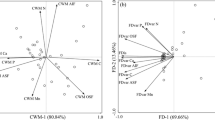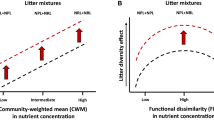Abstract
Ecosystem-level nutrient dynamics during decomposition are often estimated from litter monocultures. If species effects are additive, we can statistically predict nutrient dynamics in multi-species systems from monoculture work, and potential consequences of species loss. However, if species effects are dependent on interactions with other litter species (that is, non-additive), predictions based on monoculture data will likely be inaccurate. We conducted a 3-year, full-factorial, mixed-litter decomposition study of four dominant tree species in a temperate forest and measured nitrogen and phosphorus dynamics to explore whether nutrient dynamics in mixtures were additive or non-additive. Following common approaches, we used litterfall data to predict nutrient dynamics at the ecosystem-level. In mixtures, we observed non-additive effects of litter mixing on nutrient dynamics: the presence of nutrient-rich species in mixture facilitated nutrient release, whereas nutrient-poor species facilitated nutrient retention. Fewer nutrients were released from mixtures containing high-quality litter, and more immobilized from mixtures containing low-quality litter, than predicted from monocultures, creating a difference in overall nutrient release between predicted and actual dynamics in litter mixtures. Nutrient release at the ecosystem-level was greatly overestimated when based on monocultures because the effect of species interactions on nutrient immobilization was not accounted for. Our data illustrate that the identity of species in mixtures is key to their role in non-additive interactions, with repercussions for mineral nutrient availability and storage. These results suggest that predictions of ecosystem-level nutrient dynamics using litter monoculture data likely do not accurately represent actual dynamics because the effects of litter species interactions are not incorporated.






Similar content being viewed by others
References
Ball BA, Hunter MD, Kominoski JS, Swan CM, Bradford MA. 2008. Consequences of non-random species loss for decomposition dynamics: experimental evidence for additive and non-additive effects. J Ecol 96: 303–13
Blair JM. 1988. Nitrogen, sulfur and phosphorus dynamics in decomposing deciduous leaf litter in the southern Appalachians. Soil Biol Biochem 20: 693–701
Blair JM, Parmelee RW, Beare MH. 1990. Decay-rates, nitrogen fluxes, and decomposer communities of single-species and mixed-species foliar litter. Ecology 71: 1976–85
Brandtberg PO, Lundkvist H. 2004. Does an admixture of Betula species in Picea abies stands increase organic matter quality and nitrogen release? Scand J For Res 19: 127–41
Briones MJI, Ineson P. 1996. Decomposition of eucalyptus leaves in litter mixtures. Soil Biol Biochem 28: 1381–8
Chapman K, Whittaker JB, Heal OW. 1988. Metabolic and faunal activity in litters of tree mixtures compared with pure stands. Agric Ecosyst Environ 24: 33–40
Conn C, Dighton J. 2000. Litter quality influences on decomposition, ectomycorrhizal community structure and mycorrhizal root surface acid phosphatase activity. Soil Biol Biochem 32: 489–96
Cromack K, Monk CD 1975. Litter production, decomposition, and nutrient cycling in a mixed hardwood watershed and a white pine watershed. In: Howell FG, Gentry JB, Smith MH, Eds. Mineral cycling in southeastern ecosystems. Springfield (VA): National Technical Information Service. pp 609–24
Drake JM. 2003. Why does grassland productivity increase with species richness? Disentangling species richness and composition with tests for overyielding and superyielding in biodiversity experiments. Proc R Soc Lond B Biol Sci 270: 1713–9
Dutta RK, Agrawal M. 2001. Litterfall, litter decomposition and nutrient release in five exotic plant species planted on coal mine spoils. Pedobiologia 45: 298–312
Ellison AM, Bank MS, Clinton BD, Colburn EA, Elliott K, Ford CR, Foster DR, Kloeppel BD, Knoepp JD, Lovett GM, Mohan J, Orwig DA, Rodenhouse NL, Sobczak WV, Stinson KA, Stone JK, Swan CM, Thompson J, Von Holle B, Webster JR. 2005. Loss of foundation species: consequences for the structure and dynamics of forested ecosystems. Front Ecol Environ 3: 479–86
Engelhardt KAM, Ritchie ME. 2001. Effects of macrophyte species richness on wetland ecosystem functioning and services. Nature 411: 687–9
Fei SL, Steiner KC. 2007. Evidence for increasing red maple abundance in the eastern United States. Forest Sci 53: 473–7
Fyles JW, Fyles IH. 1993. Interaction of douglas-fir with red alder and salal foliage litter during decomposition. Can J For Res 23: 358–61
Gartner TB, Cardon ZG. 2004. Decomposition dynamics in mixed-species leaf litter. Oikos 104: 230–46
Gartner TB, Cardon ZG. 2006. Site of leaf origin affects how mixed litter decomposes. Soil Biol Biochem 38: 2307–17
Grime JP. 1998. Benefits of plant diversity to ecosystems: immediate, filter and founder effects. J Ecol 86: 902–10
Grimshaw HM, Allen SE, Parkinson JA. 1989. Nutrient elements. In: Allen SE, Ed. Chemical analysis of ecological materials. Boston: Blackwell Scientific Publications. pp 81–159
Gross K, Cardinale BJ. 2005. The functional consequences of random vs. ordered species extinctions. Ecol Lett 8: 409–18
Hättenschwiler S, Tiunov AV, Scheu S. 2005. Biodiversity and litter decomposition in terrestrial ecosystems. Annu Rev Ecol Evol Syst 36: 191–218
Heneghan L, Coleman DC, Crossley DA, Zou XM. 1999. Nitrogen dynamics in decomposing chestnut oak (Quercus prinus L.) in mesic temperate and tropical forest. Appl Soil Ecol 13: 169–75
Hobbie SE, Vitousek PM. 2000. Nutrient limitation of decomposition in Hawaiian forests. Ecology 81: 1867–77
Hooper DU, Vitousek PM. 1998. Effects of plant composition and diversity on nutrient cycling. Ecol Monogr 68: 121–49
Johnson MTJ, Lajeunesse MJ, Agrawal AA. 2006. Additive and interactive effects of plant genotypic diversity on arthropod communities and plant fitness. Ecol Lett 9: 24–34
Jones JB Jr, Wolf B, Mills HA. 1991. Organic matter destruction procedures. Plant analysis handbook: a practical sampling, preparation, analysis, and interpretation guide. Athens (GA): Micro-Macro Publishing. pp 195–6
Kaneko N, Salamanca EF. 1999. Mixed leaf litter effects on decomposition rates and soil microarthropod communities in an oak-pine stand in Japan. Ecol Res 14: 131–8
King RF, Dromph KM, Bardgett RD. 2002. Changes in species evenness of litter have no effect on decomposition processes. Soil Biol Biochem 34: 1959–63
Klemmedson JO. 1992. Decomposition and nutrient release from mixtures of gambel oak and ponderosa pine leaf litter. For Ecol Manage 47: 349–61
Kominoski JS, Pringle CM, Ball BA, Bradford MA, Coleman DC, Hall DB, Hunter MD. 2007. Nonadditive effects of leaf litter species diversity on breakdown dynamics in a detritus-based stream. Ecology 88: 1167–76
Kwabiah AB, Stoskopf NC, Voroney RP, Palm CA. 2001. Nitrogen and phosphorus release from decomposing leaves under sub-humid tropical conditions. Biotropica 33: 229–40
Larsen TH, Williams NM, Kremen C. 2005. Extinction order and altered community structure rapidly disrupt ecosystem functioning. Ecol Lett 8: 538–47
Lisanework N, Michelsen A. 1994. Litterfall and nutrient release by decomposition in 3 plantations compared with a natural forest in the Ethiopian Highland. For Ecol Manage 65: 149–64
Loreau M, Naeem S, Inchausti P, Bengtsson J, Grime JP, Hector A, Hooper DU, Huston MA, Raffaelli D, Schmid B, Tilman D, Wardle DA. 2001. Biodiversity and ecosystem functioning: current knowledge and future challenges. Science 294: 804–8
Lovett GM, Weathers KC, Arthur MA, Schultz JC. 2004. Nitrogen cycling in a northern hardwood forest: do species matter? Biogeochemistry 67: 289–8
Madritch MD, Cardinale BJ. 2007. Impacts of tree species diversity on litter decomposition in northern temperate forests of Wisconsin, USA: a multi-site experiment along a latitudinal gradient. Plant Soil 292: 147–59
McTiernan KB, Ineson P, Coward PA. 1997. Respiration and nutrient release from tree leaf litter mixtures. Oikos 78: 527–38
Melillo JM, Aber JD, Linkins AE, Ricca A, Fry B, Nadelhoffer KJ. 1989. Carbon and nitrogen dynamics along the decay continuum—plant litter to soil organic-matter. Plant Soil 115: 189–98
Mikola J, Salonen V, Setälä H. 2002. Studying the effects of plant species richness on ecosystem functioning: does the choice of experimental design matter? Oecologia 133: 594–8
Moore TR, Trofymow JA, Prescott CE, Fyles J, Titus BD. 2006. Patterns of carbon, nitrogen and phosphorus dynamics in decomposing foliar litter in Canadian forests. Ecosystems 9: 46–62
Orwig DA, Foster DR. 1998. Forest response to the introduced hemlock woolly adelgid in southern New England, USA. J Torrey Bot Soc 125: 60–73
Pandey RR, Sharma G, Tripathi SK, Singh AK. 2007. Litterfall, litter decomposition and nutrient dynamics in a subtropical natural oak forest and managed plantation in northeastern India. For Ecol Manage 240: 96–104
Parton W, Silver WL, Burke IC, Grassens L, Harmon ME, Currie WS, King JY, Adair EC, Brandt LA, Hart SC, Fasth B. 2007. Global-scale similarities in nitrogen release patterns during long-term decomposition. Science 315: 361–4
Prescott CE. 2005. Decomposition and mineralization of nutrients from litter and humus. In: BassiriRad H, Ed. Nutrient acquisition by plants. Berlin Heidelberg: Springer-Verlag. pp 15–41
Rizzo DM, Garbelotto M, Davidson JM, Slaughter GW, Koike ST. 2002. Phytophthora ramorum as the cause of extensive mortality of Quercus spp. and Lithocarpus densiflorus in California. Plant Dis 86: 205–14
Rustad LE. 1994. Element dynamics along a decay continuum in a red spruce ecosystem in Maine, USA. Ecology 75: 867–79
Salamanca EF, Kaneko N, Katagiri S. 1998. Effects of leaf litter mixtures on the decomposition of Quercus serrata and Pinus densiflora using field and laboratory microcosm methods. Ecol Eng 10: 53–73
Schimel JP, Hättenschwiler S. 2007. Nitrogen transfer between decomposing leaves of different N status. Soil Biol Biochem 39: 1428–36
Schläpfer F, Pfisterer AB, Schmid B. 2005. Non-random species extinction and plant production: implications for ecosystem functioning. J Appl Ecol 42: 13–24
Seastedt TR. 1984. The role of microarthropods in decomposition and mineralization processes. Annu Rev Entomol 29: 25–46
Singh KP, Singh PK, Tripathi SK. 1999. Litterfall, litter decomposition and nutrient release patterns in four native tree species raised on coal mine spoil at Singrauli, India. Biol Fertil Soils 29: 371–8
Smith MD, Knapp AK. 2003. Dominant species maintain ecosystem function with non-random species loss. Ecol Lett 6: 509–17
Spehn EM, Scherer-Lorenzen M, Schmid B, Hector A, Caldeira MC, Dimitrakopoulos PG, Finn JA, Jumpponen A, O’Donnovan G, Pereira JS, Schulze ED, Troumbis AY, Korner C. 2002. The role of legumes as a component of biodiversity in a cross-European study of grassland biomass nitrogen. Oikos 98: 205–18
Swift, MJ, Heal, OW, Anderson, JM. 1979. Decomposition in terrestrial ecosystems. Los Angeles: University of California Press. 361p
Vitousek PM, Aber JD, Howarth RW, Likens GE, Matson PA, Schindler DW, Schlesinger WH, Tilman DG. 1997. Human alteration of the global nitrogen cycle: sources and consequences. Ecol Appl 7: 737–50
Wardle DA, Bonner KI, Nicholson KS. 1997. Biodiversity and plant litter: experimental evidence which does not support the view that enhanced species richness improves ecosystem function. Oikos 79: 247–58
Williams BL, Alexander CE. 1991. Interactions on mixing litters from beneath Sitka spruce and Scots pine and the effects on microbial activity and N-mineralization. Soil Biol Biochem 23: 71–5
Yang YS, Guo JF, Chen GS, Xie JS, Cai LP, Lin P. 2004. Litterfall, nutrient return, and leaf-litter decomposition in four plantations compared with a natural forest in subtropical China. Ann For Sci 61: 465–76
Acknowledgments
We thank Jimmy Blackmon, Rose Cannon, and Ryan Malloy for their help in the field and laboratory. We thank Tom Maddox in the Analytical Chemistry Laboratory of the Odum School of Ecology for elemental analyses. This research was supported by National Science Foundation grants DEB-9632854 and DEB-0218001 to the Coweeta LTER Program.
Author information
Authors and Affiliations
Corresponding author
Electronic supplementary material
Below is the link to the electronic supplementary material.
Rights and permissions
About this article
Cite this article
Ball, B.A., Bradford, M.A. & Hunter, M.D. Nitrogen and Phosphorus Release from Mixed Litter Layers is Lower than Predicted from Single Species Decay. Ecosystems 12, 87–100 (2009). https://doi.org/10.1007/s10021-008-9208-2
Received:
Accepted:
Published:
Issue Date:
DOI: https://doi.org/10.1007/s10021-008-9208-2




